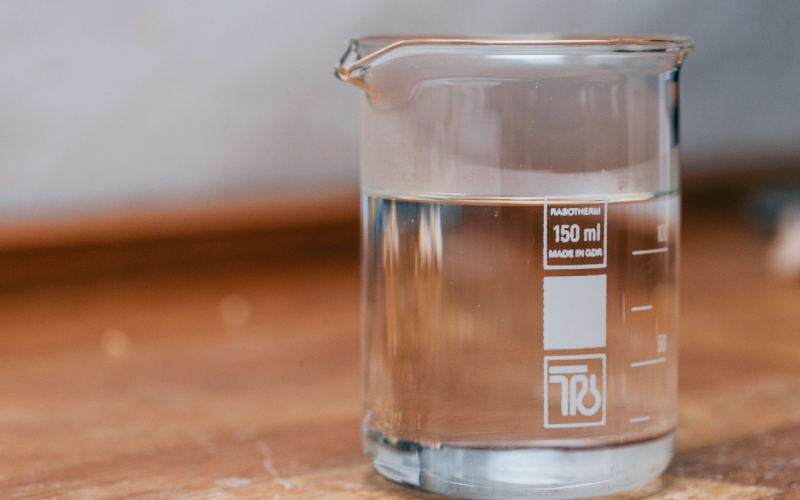Water
To bake good bread or pizza, you need to have some experience combined with a good recipe and the proper ingredients. Flour is an ingredient discussed a lot and paid special attention to when people start baking. But water! This simple ingredient is often neglected and taken for granted. That water is the second biggest ingredient in dough by volume is exactly what makes it just as important as flour.
The moment flour comes in contact with water, gluten begins to form. This process is essential for having good dough. If you don’t use the right amount of water, you won’t be able to form a nice dough.
To make the dough, you need a certain amount of water. This amount depends on the kind of product you want to make in the end. For a Neapolitan pizza, you don’t need to add much water. Neapolitan pizza is a low hydration dough that doesn’t contain a lot of water. But there are also pizza styles that use much more water in the dough, such as Teglia, Romana, and Sicilian.
Now, we know that water takes care of gluten formation. But it also does so much more. Water contributes to yeast fermentation and gives the dough consistency. It also serves as a solvent and dispersant for salt, sugar, and yeast, which are needed for fermentation. Beyond that, water assists in diluting and ensuring proper distribution in the dough of all other ingredients.
There are two approaches to incorporating water into a dough. The most common approach is to gradually pour the water into the flour. While mixing and kneading the dough, water is absorbed by the flour.
The second approach is to add flour little by little to the water. This method is useful when the ambient temperature is high. By adding the flour to the water, the dough will not heat up as quickly.
When making a pizza or bread, you can choose low or high hydration. However, it is important to keep in mind that not all flours absorb the same amount of water. The weaker the flour, the less water you need; the stronger the flour, the more water you can use.

It’s the % of water added to the dough, calculated in comparison to the total flour.
For example
65% hydration = 650g water: 1000g flour = 0.65%
The benefits of a high hydration dough are rapid growth and development of dough and a more immediate fermentation. How? A dough with higher hydration has the following properties:
– Increased swelling of starch
– Increased swelling of proteins
– Increased enzymatic activity
– Rapid conversion of sugars, which are nutrients for the yeast
Dough temperature plays a big role in the end product. If you want to get consistency in your end product, you need to control the temperature of your dough. The final temperature of the dough depends on several factors.
Water temperature (WT)
Ambient temperature (AT)
Flour temperature (FT)
Friction Factor (FF)
The easiest way to control your dough temperature is with water. First of all, a more hydrated dough will generally have a higher final temperature and vice versa. Second, using too warm water results in delayed (if not missed) formation of the gluten mesh. The dough will have a very soft, almost “loose” consistency. Using water that is too cold can slow down fermentation and enzymatic activities in the dough. Water temperature is thus very important to achieve a dough with an accurate final temperature.
The ideal temperature of your final pizza dough is between 21-25°C.
The formula for hand mixing: 60 – (ambient temperature C° + flour C°)
For example
Ambient temperature: 23°C
Flour temperature: 22°C
Water temperature: 60 – (23 + 22) = 15°C.
The formula for machine mixing: (Desired C ° x 3) – (Ambient temperature C ° + Flour C ° + machine friction C °)
For Example:
Desired temperature: 24°C
Ambient temperature: 21°C
Flour temperature: 20°C
Machine friction: 10°C
Water temperature: (24 x 3) – (21 + 20 + 10) = 21 C°
The friction factor represents the amount of heat transferred to the dough during mixing and kneading (by machine). Friction can increase the dough temperature significantly, so it has to be considered when making dough temperature calculations. Especially with small batches of dough or very dry dough, the temperature rises quickly. The temperature will not rise as much with larger batches or wet dough. Unfortunately, there is no fixed number for the friction factor (by this I mean that every machine has a different effect on dough temperature). So if you want to know what friction factor ”your” machine has, you must first make a test batch of dough. Write down the temperature of the water (WT) used, the ambient temperature (AT), the temperature of the flour (FT), and the temperature of the final dough (FDT). Then the friction factor (FF) can be calculated with the following formula: FF = (3 x FDT) – (AT + FT + WT).





